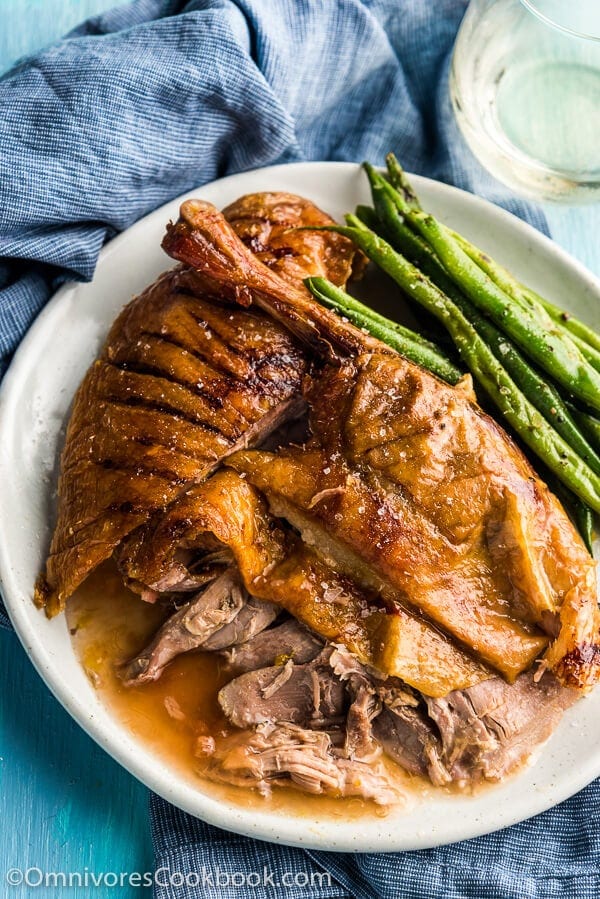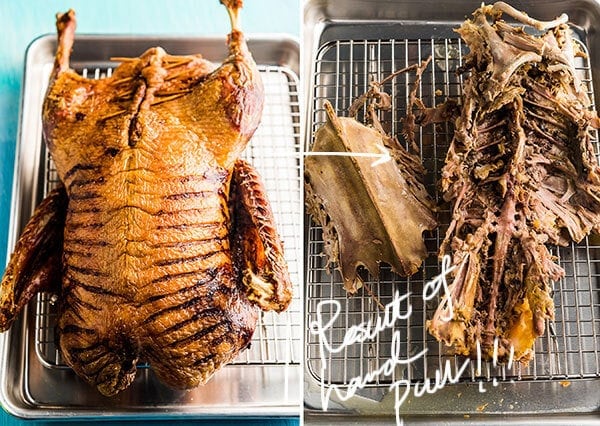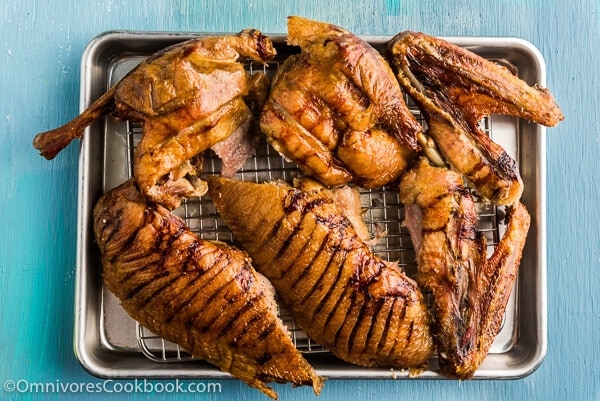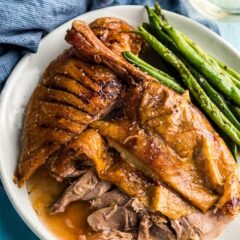
Having grown up in Beijing, I have a special attachment to duck. We’re spoiled by ubiquitous perfectly roasted Peking duck, a luxurious yet affordable dining choice that we enjoy a few times a year. I can finish half a duck myself. I enjoy eating the duck skin by itself with a bit of sauce (without the meat and without the pancake). In my world, it tastes way better than crispy bacon.
Since moving to the US, I’ve been craving duck.
The first time I dealt with a whole duck, I slow cooked it Mediterranean style. I quartered the duck, placed it on a bed of vegetables and herbs, and slow cooked it until tender. Right before serving, I crisped up the skin by heating the duck pieces under the broiler. It generated nearly duck-confit texture.
It was almost perfect, but my friend and reader Saint Phlip told me there was a better way.
The best slow roast duck
This recipe was originally shared by the chef of a hotel restaurant in Marietta, Ohio. According to Saint Phlip, it’s the tastiest duck she’s ever tried.
To cook the duck, you stuff it with several citrus fruits, then roast it at a very low temperature (95 to 120 C / 200 to 250 F). It requires a long, slow roast. But you don’t need to do anything during the roasting. No flipping, no touching.


When you’ve almost forgotten the duck, 5 hours later, you will suddenly smell a wonderful aroma coming from the kitchen. That’s when you know the duck is getting good.
The next 2 hours will be the most difficult. Your room will be filled with the wonderful roasting fragrance that reminds you of a steak house. You’ll start to check on the duck every 10 minutes, wondering why it’s still not ready. DO NOT pull out the duck now. Be patient!
When you start to worry that you’ve roasted it for too long and suspect the duck meat has lost its moisture, your dinner is ready.
You will be amazed when try to move the duck onto a carving board. You might accidentally crack the skin apart or pull a leg off. I know it’s cliche to say this, but the duck is literally fall-off-the-bone tender (as proof of my words, see the picture below). You might end up serving a “pulled duck”, since it’s nearly impossible to keep the whole thing intact. Restrain yourself from snacking on the crispy skin. You might finish the whole thing before you have a chance to serve your guests.

Cooking notes
Don’t be scared away by the long cooking time of this recipe, because:
- The active prep time is 10 minutes. And you’ll need another 10 minutes to cook the sauce and serve the duck. In total, there’s only 20 minutes of active cooking time.
- You can cook the duck one day or several days ahead, freeze the duck, and serve it later.
- If you’re serving the duck for a party, you can start roasting it in the morning, then heat it up before dinner.
Compared to roasting a perfect chicken, roasting the best duck is much easier. And it is definitely more festive.
There are a few good ways to serve the duck. In the recipe below, I introduce the original sauce recipe – a delightful and sweet sauce made from white wine and fruit preserves.
For those who miss a perfectly roasted Peking duck from back home, cook duck pancakes, and serve everything with chopped green onions and cucumbers. I guarantee you the dish will taste just like home.
For those who enjoy a savory sauce, head over to the Mediterranean duck recipe and cook the olive sauce.

Do you like my recipes? Sign up our weekly newsletter to get the latest updates delivered to your inbox and a FREE e-cookbook that contains my top 30 most popular recipes!
Chinese Cooking Made Easy
Are you new to this website? This free email series is a great place to start. I’ll walk you through a few of my most popular recipes and show you how and why they work. You’ll quickly start to cook better Chinese food in your own kitchen.

Duck de Marietta (The Best Slow Roast Duck)
Ingredients
Duck
- 1 2.5 kg / 5 to 6 pound whole duck (I used D'Artagnan Rohan Duck)
- 5 to 6 mixed citrus fruits blood orange, lemon, and/or mandarin, peels removed
- Sea salt
Sauce (*see footnote)
- 4 tablespoons jam of your choice (blueberry, apricot, etc.)
- 1 cup white wine
- 2 to 4 tablespoons potato starch (or cornstarch)
Instructions
- Adjust oven rack to the lower third. Preheat oven to 120 C (250 degrees F). Line a baking pan with aluminium foil (for easy cleanup) and top with a V-rack.
- Prepare a plate. Transfer the giblets from the duck to the plate. Use a pair of poultry shears to remove the duck neck and trim the neck skin. Do not trim any skin from the bottom of the duck, because it will keep the meat moist during roasting. Save the duck neck for making sauce or stock. Save the giblets for cooking or making stock.
- Place duck on a working surface or a cutting board. Stuff citrus inside of the duck, using as many fruits as you can. Use a few toothpicks to seal the bottom of the duck, to secure the fruits inside.
- Use a sharp paring knife to score the duck breast, about 1 cm (⅓ inch) apart. This will help the duck render fat faster and create a crispy skin. If you’re not familiar with this process, I suggest you start slow. The thickness of duck skin is not consistent. You need to avoid slicing through the meat, which will cause the duck to lose moisture. Gently press the knife. You might need to slice a few times to get the cut just right. (*see footnote 1)
- Rub both sides of the duck with plenty of sea salt. Place duck on the V-rack, breast side up.
- Bake until the skin turns golden brown, 6 to 7 hours (depending on the thickness of the duck skin). You do not need to flip the duck or monitor the process.
- (Optional) When most of the duck fat has rendered and the skin has become thin (usually 6 hours to 6.5 hours), turn up the heat of the oven to 260 degrees C (500 F) to brown the duck for another 5 to 10 minutes. This method works better when you choose a duck breed with thinner skin (or a duck that was air-chill processed). The skin will crisp up nicely and the meat will remain more juicy.
- Remove the duck from the oven and let rest for 15 minutes. Do NOT cover the duck with foil. This step further crisps up the skin. The stuffing will keep the duck meat hot.
- Transfer the duck onto a large cutting board. Carefully remove the citrus fruits (they will be very hot!) from the duck with a fork or a pair of tongs, and discard them.
- To carve the duck beautifully, you can refer to this video. Alternatively, you can simply pull the meat apart by hand.
- Transfer the rendered duck fat into a small bowl. When it has cooled off, cover with plastic wrap and store it in the fridge. Save for later use.
Option 1 - Fruity sauce
- While resting the duck, cook the fruit sauce.
- Dissolve potato starch in a few tablespoons of the white wine.
- Heat the rest of the white wine in a small saucepan until warm. Add jam of your choice. Stir and mix so that the jam incorporates with the wine. When the liquid comes to a simmer, taste it and adjust the flavor by adding more wine or jam. Remove the pan from the stove.
- Stir the potato starch slurry again to let it fully dissolve in the wine. Slowly pour it into the sauce, stirring at the same time. Add enough slurry to get the sauce to the desired thickness.
- Pour a few spoonfuls of the sauce onto a serving plate. Place the carved the duck onto the sauce. Serve warm with extra sauce on the side.
Option 2 - Peking duck
- Cook duck pancakes (or use store-bought ones). Steam to heat them up while resting the duck.
- Serve duck and pancakes with hoisin sauce, sliced green onion, and sliced cucumber.
Storage
- If you’re not serving the duck right away, wrap the meat in aluminum foil and let it cool down to room temperature. Move it to a ziplock bag, press out as much air as possible, and store it in the fridge for up to 2 days or in the freezer for up to a month.
- To reheat, place the duck, skin side up, on a roasting pan. Transfer into the oven and preheat to 260 degrees C (500 F). Bake until the duck heats up and the skin turns crispy, 10 to 15 minutes.
(Optional) Giblets
- Cut duck giblets (liver, heart, and gizzard) into even-sized chunks and combine with a spoonful of Chinese distilled liquor (白酒, bai jiu), vodka, or Shaoxing wine in a small bowl. Add a teaspoon of cornstarch and season with salt. Mix well. Marinate for 5 minutes.
- Heat oil in a skillet. Gently cook the giblets over medium low heat until cooked through and the surface browned.
- Season with black pepper and serve warm.
Notes
- Many recipes suggest puncturing the duck meat with a sharp knife or fork. I personally do not like that method so much. It is slower and the duck won’t look so pretty compared to one with scored skin.

Did you make this recipe?
I’d love to hear how it turned out for you! Please take a moment to leave a 5-star rating ⭐️ and share your thoughts in the comments further down the page. It really helps others discover the recipe too.
This is a festive dish, so we’re not going to count calories here 🙂

Nick
Best method I’ve ever come across for cooking duck. The usual problem is either the legs are done and the breast is dry or the breast is good but the legs are raw. I’ve seen recipes that get you to cut the bird up and cook separately but this is way better. The legs come off like confit and the breast is cooked through but tender, a meat you can pull apart. You also actually get the wings which normally get pretty much incinerated with other methods. I’m really surprised this method doesn’t show up everywhere as the way to cook a duck. Thank you for sharing it.
Gwen
The skin was indeed amazing, but the meat quite dry, and the citrus a complete waste (I knew that, I have never found that stuffing the cavity a poultry with herbs or anything actually flavors the meat. It scents the air, but that’s it…). The skin scoring is a good tip that I’ll use again, thank you for teaching me that =) but next time I’ll either cook the duck in a dutch oven on low temperature, or cook it for a shorter time (4-5 hours) to keep some moisture in the meat.
Felipe
Absolutely amazing recipe. I too love duck, and believe this recipe is simple and gets amazing flavors and textures. Thank you very much for sharing!!
Joanne
Hi, Maggie. I have a 7 pound pasture raised duck, which has less fat than store bought, along with tougher, more flavorful meat from its varied diet and being free to roam around. I’d like to try something other than braising the duck and your recipe sounds delicious! Do you think this recipe would work for pastured duck? Do you suggest any adjustments to time or temperature? Thank you.
Maggie
Hi Joanne, I think the recipe will work for you. I’ve made this dish several times, and I did use less fatty ducks before (not pasture raised but still had a thinner skin) and it came out well. The recipe is rather forgiving. Since the duck contains less fat, the skin might crisp towards the end so you might need less time to brown the skin at a high temperature.
Todd
Made this yesterday. OMG so easy and such a great taste. I cooked it at 225 for 6 hours, 275 for 1 hour and 500 for 15 min.
Isla Adele
Hello Maggie, just wanted to thank you for this lovely recipe. I tried it a couple of years ago I think and meant to comment, but never did, and here I am coming back and delighted to find it again as I’m hoping to make it for my mum this coming Mothering Sunday.
I can only source Gressingham ducks where I am in the UK and they are bred to have maximum flesh with much less fatty skin – sounds great, but not ideal for the skin-lovers and fans of super-slow cooking amongst us! Nevertheless, your recipe still produced the best duck I’ve ever made when I first used it, so however skinny the duck, it still works.
Thank you again for sharing this, and I hope you and your loved ones are safe and healthy during these crazy times.
Bill
Absolutely easiest best tasting roast duck!!!!!!!!!
Jan Warnke
Excellent! Guests loved it. I might salt the duck overnight like I do when I make confit de canard. Thanks Maggie!
Edward Filippini
I’ve tried a couple different recipes for duck in the past few months so had to try this one, even though it appeared way too simple. I bought the duck a few days ago and let it sit naked in the fridge to thaw and dry out a bit. Yesterday I went to my market and found that the only citrus they had was oranges (!) but bought a couple and put them in the cavity this morning. Into the oven at about 10am and forgot about until 5 or so. Stunning! I ate one thigh/leg and all stray crispy bits. Very good. I plan to do this more often!
Melissa
I’ve never reviewed a recipe before, but this one is worth the effort. I have made this duck twice so far: once for my family the first [and so far only] the I hosted Christmas Eve, and once as one of the meat options at a 20+ person Friendsgiving [alongside a second duck steamed then finished on the grill, a rib roast, and tri tip]. It has been a tremendous success every time, and no matter how much I hope for them we’ve never had leftovers. Which is why I’m going to use this recipe a third time this weekend: this time it’s just for my husband and I to savor without having to share.
It’s hard to find a recipe that everyone enjoys, but this has easily hit that mark. If anyone is apprehensive about giving it a try, don’t doubt: it’s absolutely worth it, and has converted multiple people into duck lovers.
[Bonus: I give my dad the carcasses and he uses them to make congee.]
Martin
I was on my own for Thanksgiving yesterday and had already had a duck ready to cook. I tried your recipe and it was great. The meat was tender and literally fell off the carcass (which I gave to the local feral animals for their Thanksgiving treat). I paired it with wild rice and JK’s Scrumpy hard cider for a sweet contrast.
Amber
If I were to pass on the fruit side of things, maybe stuff the duck with stuffing, how would that effect cooking time? Are there any other ways to stuff a duck what you would reccumend?
Maggie
Hi Amber, I’m afraid I cannot provide a great answer since I’ve never cooked the dish using other stuffings.
Harriet
Hi Maggie! I truly appreciate all of your and replies to questions.
My husband and I are going to be making 2 ducks for thanksgiving! In the storage section the instructions state: To reheat, place the duck, skin side up, on a roasting pan. Transfer into the oven and preheat to 260 degrees C (500 F). Bake until the duck heats up and the skin turns crispy, 10 to 15 minutes.
Do we preheat the oven with the duck inside already? Or should we preheat and then put the duck in (which is what I would expect!)
Maggie
Hi Harriet, yep, you should preheat the oven and then put the duck in. Happy cooking and I hope you enjoy the dish!
Sue
My husband LOVES duck; he’ll order it at a restaurant almost every time. I had never tried cooking a duck, until THIS perfect recipe. Foolproof and amazingly delicious. I also made the sweet sauce with cherry preserves, it was wonderful as well. My husband will probably never order duck at a restaurant again.
Kristina
Hello Maggie, Sweden cooking/calling 🙌
Thank you for this recipe, watching the duck slowly do it’s drip drip drop, whilst the aroma spreads in the kitchen. Is a big fan of low tempered cooking, so I’m trying Geirs modifications 100 * C for 5 h etc.
Chopped up too much citrus fruits so I used that+ carrots, leek, giblets, orange marmalade, star anise, tomato paste, white wine and water to make a sauce foundation, also on a slow burn on the stove, now waiting for the filling, could it get more Zen 😂?!
Perhaps I’ll serve it with some duck fat potatoes and grilled fennel and a dash of cream in the sauce, because why not (🙈😂🙈)
Ps. Had a mishap on the scoring and harmed the breast meat, hope that it’s not doomed!
If so, they say practice make perfect so: Get up on that horse again, as we say in Sweden!Ds
Again, thanks for sharing‼
Mrs Arthur
I made this and it’s one of the best things I’ve ever made in my life. I will be making this again and again. Thank you VERY much for sharing. I’ll be looking at more of your recipes. Thanks!!
Scot
Wow wow wow. That duck was amazing we wil definitely be making that atand again We went with a n apricot preserves mixed with kung fu girl Riesling wine for the fruit sauce and it was amazing Thank you again
Chris
Thank you so very much . for . this . recipe.
I prepared this yesterday, 12/30/18 with the most satisfying results.
Wishes for a safe and truly Blessed New Year !
Shamin
I made this recipe for Christmas yesterday. Wow! Absolutely perfect. I had a small duck about 2kg. Mine was fall off the bone tender in 6 hours at 120 degrees C. I did mine in the evening of the 24th and just reheated for Christmas lunch. It’s the first time that I ever prepared a duck and I’m so glad I did. Thank you for this foolproof recipe. I will most certainly make it again.
Arlyne
Maggie … this was THE BEST DUCK that I have ever roasted … made this for Christmas Day and I have to admit that I was a bit apprehensive regarding the 7 hour cooking time but you made me a believer … I have NEVER had a roasted duck turn out so tender … BRAVA!